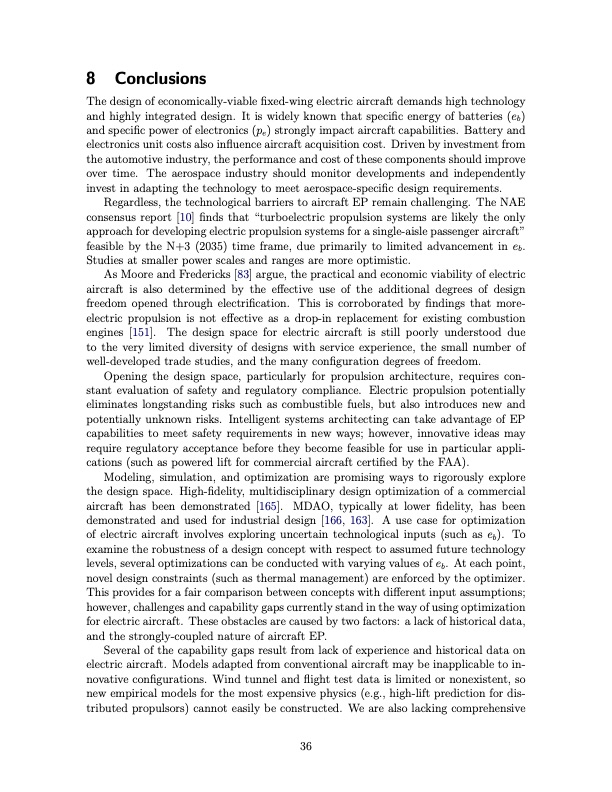
PDF Publication Title:
Text from PDF Page: 037
8 Conclusions The design of economically-viable fixed-wing electric aircraft demands high technology and highly integrated design. It is widely known that specific energy of batteries (eb) and specific power of electronics (pe) strongly impact aircraft capabilities. Battery and electronics unit costs also influence aircraft acquisition cost. Driven by investment from the automotive industry, the performance and cost of these components should improve over time. The aerospace industry should monitor developments and independently invest in adapting the technology to meet aerospace-specific design requirements. Regardless, the technological barriers to aircraft EP remain challenging. The NAE consensus report [10] finds that “turboelectric propulsion systems are likely the only approach for developing electric propulsion systems for a single-aisle passenger aircraft” feasible by the N+3 (2035) time frame, due primarily to limited advancement in eb. Studies at smaller power scales and ranges are more optimistic. As Moore and Fredericks [83] argue, the practical and economic viability of electric aircraft is also determined by the effective use of the additional degrees of design freedom opened through electrification. This is corroborated by findings that more- electric propulsion is not effective as a drop-in replacement for existing combustion engines [151]. The design space for electric aircraft is still poorly understood due to the very limited diversity of designs with service experience, the small number of well-developed trade studies, and the many configuration degrees of freedom. Opening the design space, particularly for propulsion architecture, requires con- stant evaluation of safety and regulatory compliance. Electric propulsion potentially eliminates longstanding risks such as combustible fuels, but also introduces new and potentially unknown risks. Intelligent systems architecting can take advantage of EP capabilities to meet safety requirements in new ways; however, innovative ideas may require regulatory acceptance before they become feasible for use in particular appli- cations (such as powered lift for commercial aircraft certified by the FAA). Modeling, simulation, and optimization are promising ways to rigorously explore the design space. High-fidelity, multidisciplinary design optimization of a commercial aircraft has been demonstrated [165]. MDAO, typically at lower fidelity, has been demonstrated and used for industrial design [166, 163]. A use case for optimization of electric aircraft involves exploring uncertain technological inputs (such as eb). To examine the robustness of a design concept with respect to assumed future technology levels, several optimizations can be conducted with varying values of eb. At each point, novel design constraints (such as thermal management) are enforced by the optimizer. This provides for a fair comparison between concepts with different input assumptions; however, challenges and capability gaps currently stand in the way of using optimization for electric aircraft. These obstacles are caused by two factors: a lack of historical data, and the strongly-coupled nature of aircraft EP. Several of the capability gaps result from lack of experience and historical data on electric aircraft. Models adapted from conventional aircraft may be inapplicable to in- novative configurations. Wind tunnel and flight test data is limited or nonexistent, so new empirical models for the most expensive physics (e.g., high-lift prediction for dis- tributed propulsors) cannot easily be constructed. We are also lacking comprehensive 36PDF Image | Electric, hybrid, and turboelectric fixed-wing aircraft

PDF Search Title:
Electric, hybrid, and turboelectric fixed-wing aircraftOriginal File Name Searched:
Brelje2019-ElectricHybridandTurboelectricFixed-WingAircraftAReview.pdfDIY PDF Search: Google It | Yahoo | Bing
NFT (Non Fungible Token): Buy our tech, design, development or system NFT and become part of our tech NFT network... More Info
IT XR Project Redstone NFT Available for Sale: NFT for high tech turbine design with one part 3D printed counter-rotating energy turbine. Be part of the future with this NFT. Can be bought and sold but only one design NFT exists. Royalties go to the developer (Infinity) to keep enhancing design and applications... More Info
Infinity Turbine IT XR Project Redstone Design: NFT for sale... NFT for high tech turbine design with one part 3D printed counter-rotating energy turbine. Includes all rights to this turbine design, including license for Fluid Handling Block I and II for the turbine assembly and housing. The NFT includes the blueprints (cad/cam), revenue streams, and all future development of the IT XR Project Redstone... More Info
Infinity Turbine ROT Radial Outflow Turbine 24 Design and Worldwide Rights: NFT for sale... NFT for the ROT 24 energy turbine. Be part of the future with this NFT. This design can be bought and sold but only one design NFT exists. You may manufacture the unit, or get the revenues from its sale from Infinity Turbine. Royalties go to the developer (Infinity) to keep enhancing design and applications... More Info
Infinity Supercritical CO2 10 Liter Extractor Design and Worldwide Rights: The Infinity Supercritical 10L CO2 extractor is for botanical oil extraction, which is rich in terpenes and can produce shelf ready full spectrum oil. With over 5 years of development, this industry leader mature extractor machine has been sold since 2015 and is part of many profitable businesses. The process can also be used for electrowinning, e-waste recycling, and lithium battery recycling, gold mining electronic wastes, precious metals. CO2 can also be used in a reverse fuel cell with nafion to make a gas-to-liquids fuel, such as methanol, ethanol and butanol or ethylene. Supercritical CO2 has also been used for treating nafion to make it more effective catalyst. This NFT is for the purchase of worldwide rights which includes the design. More Info
NFT (Non Fungible Token): Buy our tech, design, development or system NFT and become part of our tech NFT network... More Info
Infinity Turbine Products: Special for this month, any plans are $10,000 for complete Cad/Cam blueprints. License is for one build. Try before you buy a production license. May pay by Bitcoin or other Crypto. Products Page... More Info
| CONTACT TEL: 608-238-6001 Email: greg@infinityturbine.com | RSS | AMP |